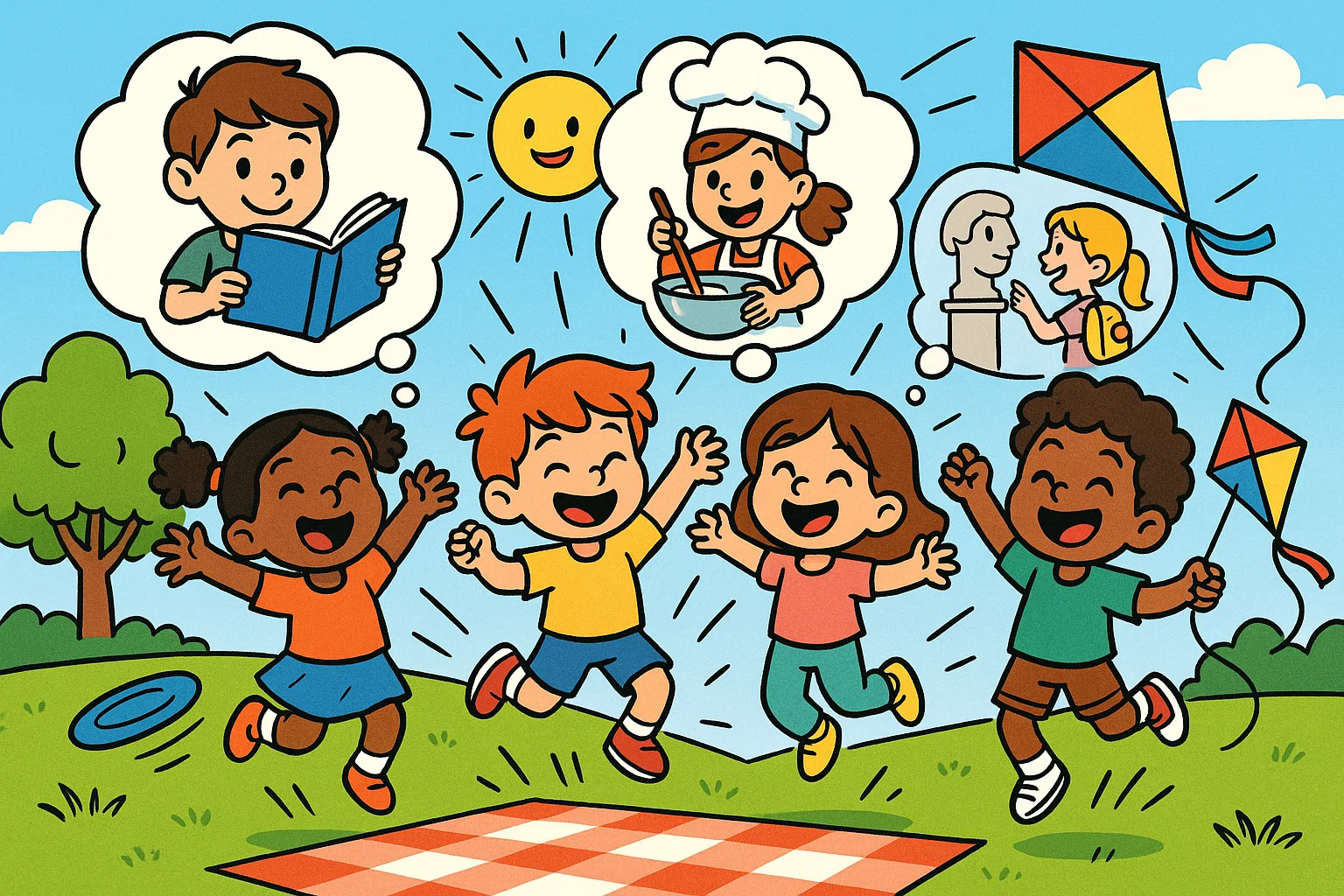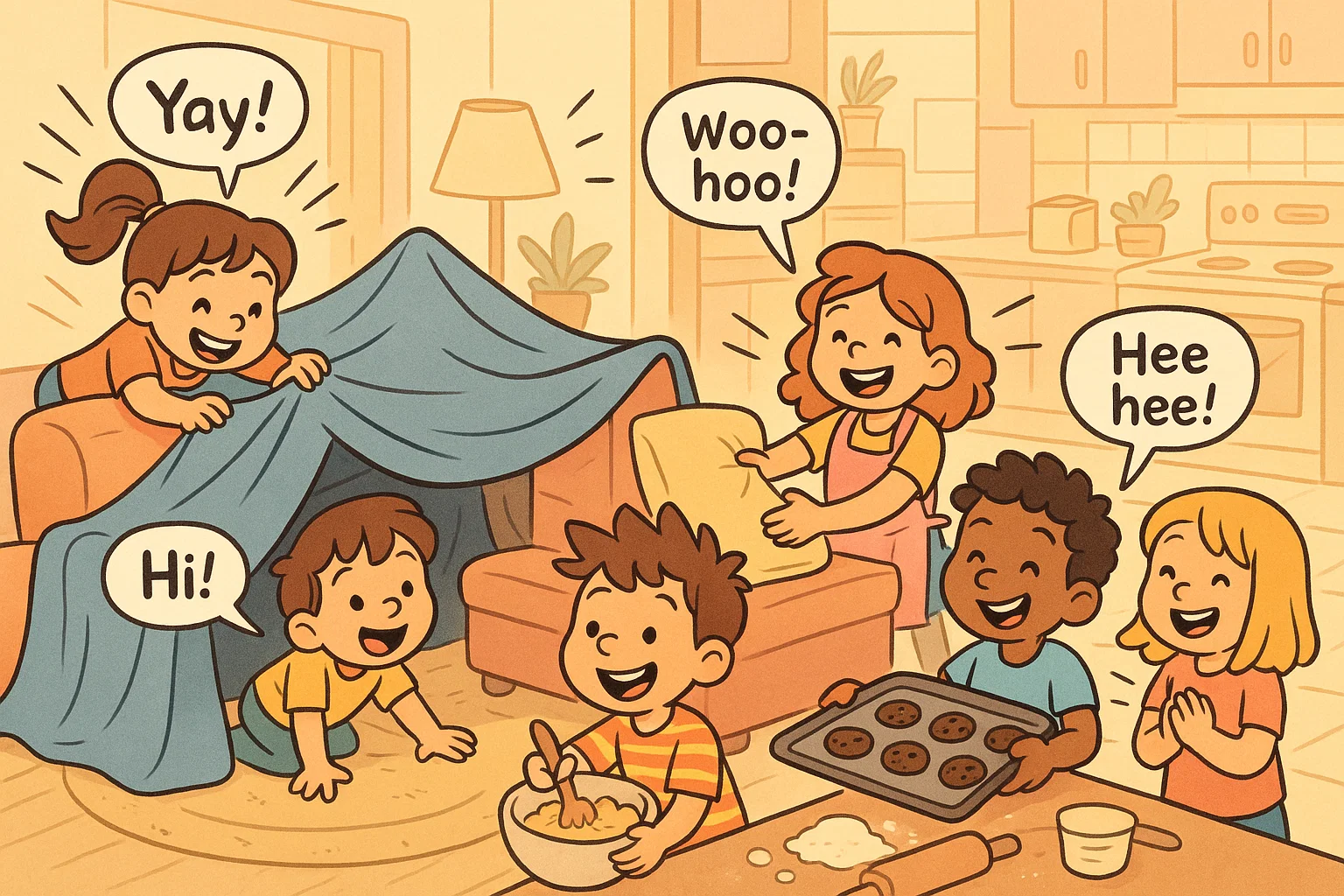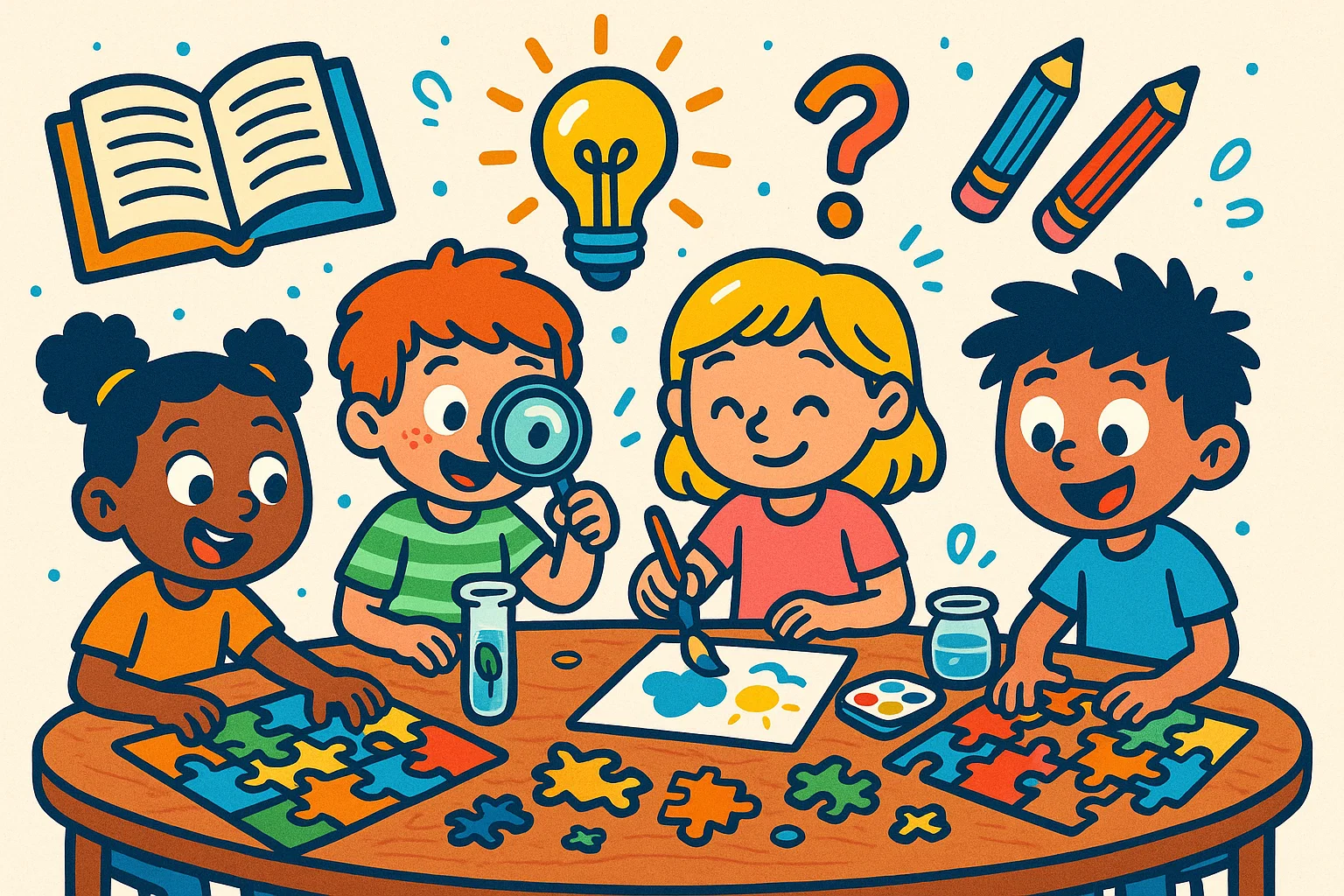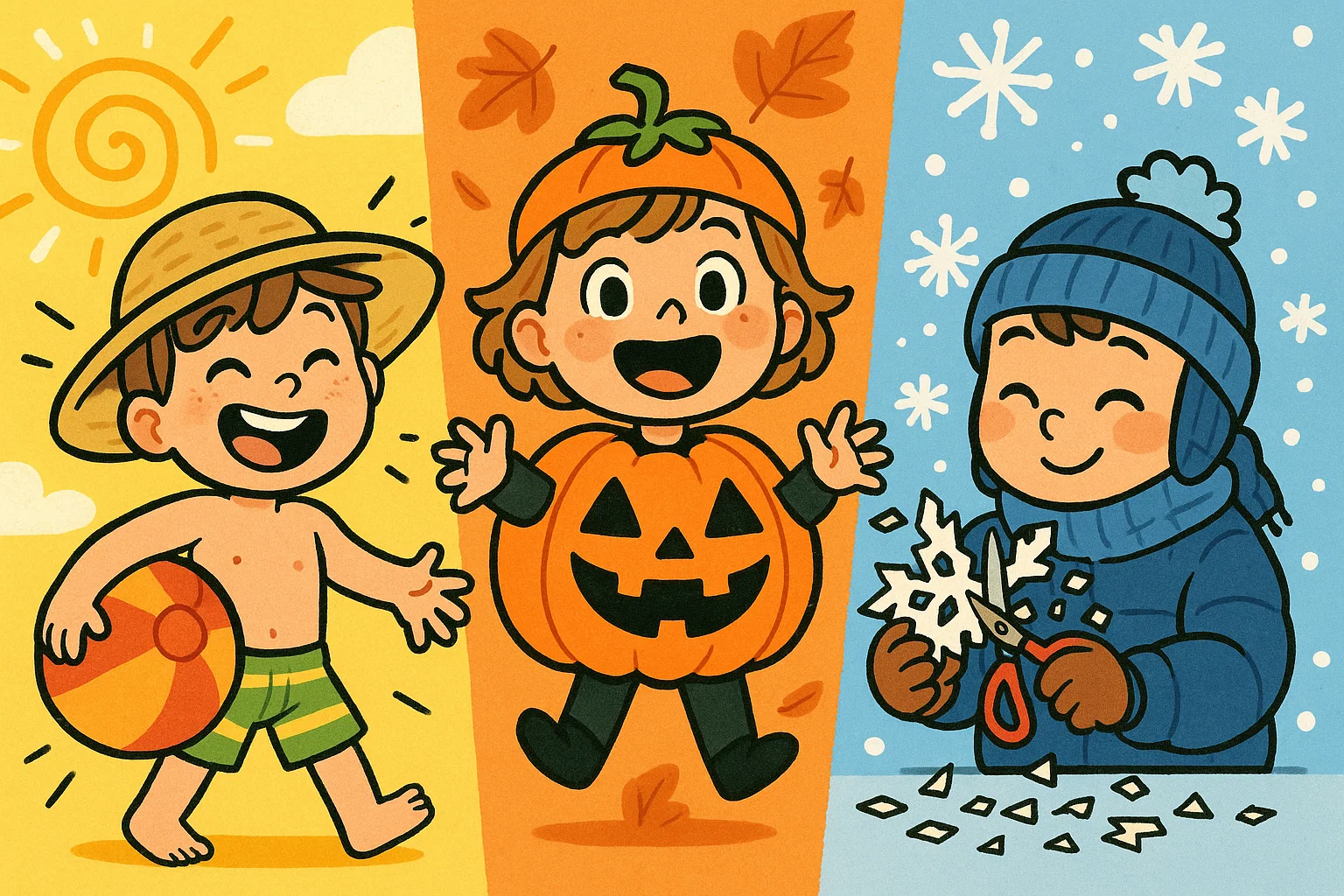18 Ideas for School Holidays

School holidays can be both exciting and stressful. You look forward to extra time with your kids, but keeping them entertained for weeks can quickly feel overwhelming.
This guide gives you over 50 creative and budget-friendly activity ideas — from backyard adventures to simple educational games — that will keep children of all ages engaged, curious, and happy throughout the holidays.
Outdoor School Holiday Ideas
Fresh air and physical activity are essential for children’s wellbeing, and outdoor activities offer endless possibilities for family fun. According to research published in the Journal of Environmental Psychology, children who spend at least two hours outdoors daily show improved concentration, reduced stress levels, and better sleep patterns.
Backyard Adventures
Your garden can become an exciting playground with minimal preparation. Create a treasure hunt using simple clues that lead to small prizes hidden around outdoor spaces. Design an obstacle course using household items like chairs, ropes, and cardboard boxes – kids like the challenge of beating their previous times.
Set up a paddling pool for water play, or install a sprinkler for hot summer days. Build dens using old sheets, garden furniture, and your imagination. Bug-watching expeditions can captivate little ones for hours – provide magnifying glasses and encourage them to create nature journals documenting their discoveries.
Garden games like hide-and-seek, tag, or classic hopscotch require no equipment and provide excellent exercise. Consider creating a mini camping experience by pitching a tent overnight, complete with storytelling and stargazing sessions.
Day Trips to Local Attractions
Explore your local area with fresh eyes. Visit your local park for picnics, playground fun, and nature walks. Many parks offer free activities during school holidays, including guided walks and wildlife spotting sessions.
Garden centres often provide educational opportunities – children can learn about different plants, observe seasonal changes, and sometimes participate in planting workshops. Local libraries frequently organize outdoor story sessions and nature-themed activities during holiday periods.
Consider visiting National Trust properties, which offer excellent value for families. Many sites provide child-friendly trails, historical reenactments, and hands-on activities. English Heritage locations also offer engaging experiences that combine education with entertainment.
Pack lunches to make day trips more affordable, and check local websites for special events or discounted entry days.
Outdoor Sports and Challenges
Physical activities help burn energy while developing coordination and teamwork skills. Organize family cycling adventures on local bike trails, or participate in junior parkrun events that welcome children from age 4 upward.
Create sporting challenges in your garden or local park – set up football goals, practice cricket, or organize frisbee competitions. Water balloon fights provide cooling relief during hot weather while encouraging active play.
Community sports centers often run holiday clubs with professional coaching at reasonable prices. Swimming sessions can be particularly appealing – many councils offer free swimming for children during school holidays.
Camping and Nature Exploration
Camping doesn’t require expensive equipment or distant destinations. Backyard camping allows nervous first-timers to experience outdoor sleeping in familiar surroundings. Use this opportunity to teach basic outdoor skills like tent setup, compass reading, and identifying local wildlife.
Nature photography expeditions can occupy older children for extended periods. Provide disposable cameras or smartphones and challenge them to capture specific subjects – flowers, insects, interesting cloud formations, or architectural details.
Visit nearby forests or countryside areas for hiking adventures. Create nature scavenger hunts with lists of items to find: specific leaves, rocks, bird sounds, or animal tracks.
Indoor School Holiday Ideas
Rainy days and quiet moments at home needn’t mean boredom. Indoor activities can be equally engaging and often provide opportunities for focused learning and creativity.
Creative Arts and Crafts
Art supplies don’t need to be expensive – use toilet roll tubes, egg boxes, and cardboard packaging for creative projects. Create seasonal decorations, design greeting cards, or build model castles from recycled materials.
Painting activities can range from simple finger painting for toddlers to complex landscape attempts for older children. Set up dedicated art spaces with washable surfaces and provide smocks or old clothes to encourage messy creativity.
Clay modeling develops fine motor skills while encouraging imagination. Air-dry clay is convenient and mess-free, perfect for creating small sculptures, decorative bowls, or miniature figures.
Ideas for art projects include:
- Seasonal collages using magazine cutouts
- Homemade playdough in various colors
- Paper mache sculptures
- Friendship bracelets and jewelry making
- Tie-dye projects using old t-shirts
Indoor Games and Puzzles
Board games provide excellent entertainment while developing strategic thinking and social skills. Classic games like Monopoly, Scrabble, or Clue can occupy families for hours. Lego building challenges encourage engineering thinking – set themes like “tallest tower” or “most creative vehicle.”
Create indoor obstacle courses using furniture, cushions, and tape markers. Design escape-room challenges using riddles, hidden clues, and simple puzzles that lead to rewards.
Jigsaw puzzles offer quiet activity options for different skill levels. Start collaborative family projects with 1000+ piece puzzles that can be completed over several days.
Baking and Cooking Together
Kitchen activities teach valuable life skills while creating delicious results. Simple recipes like cupcakes, biscuits, or homemade pizza allow children to measure ingredients, follow instructions, and understand basic cooking processes.
Safety considerations include age-appropriate tasks – younger children can stir mixtures and decorate finished products, while older children can handle simple cutting and stovetop activities under supervision.
Popular kid-friendly recipes include:
- No-bake chocolate cookies
- Fruit smoothies and milkshakes
- Decorated sugar cookies
- Homemade bread rolls
- Colorful vegetable salads

| Age Group | Suitable Tasks | Safety Considerations |
| 3-5 years | Mixing, decorating, washing vegetables | Constant supervision, no sharp tools |
| 6-8 years | Measuring, simple cutting, cracking eggs | Supervised knife use, no stovetop |
| 9+ years | Independent preparation, basic cooking | Stovetop with guidance, safety rules established |
Home Cinema Experience
Transform your living room into a movie theater with simple decorations and special snacks. Create ticket stubs, dim lighting, and prepare popcorn or themed snacks related to chosen films.
Cbeebies offers excellent programming for younger viewers, while family-friendly classics appeal to mixed-age groups. Consider having themed movie nights – superhero movies with cape-making activities, or nature documentaries followed by garden exploration.
Encourage older children to research and present film facts, create movie reviews, or design promotional posters for their favorite films.
Budget-Friendly School Holiday Ideas
Entertaining children doesn’t require significant financial investment. Many of the most memorable activities cost very little or are completely free.
Free Local Events and Workshops
Local libraries serve as excellent resources for free activities. They typically offer story times, craft sessions, computer classes, and reading challenges during school holidays. Libraries are also great places to borrow books, audiobooks, and sometimes even board games or puzzles.
Community centers frequently organize free events including art workshops, sports sessions, and cultural celebrations. Check local council websites and community bulletin boards for upcoming activities.
Museums and galleries often provide free entry days or special children’s programs. Many supermarkets run kids’ clubs with free activities and healthy snacks during holiday periods.
Upcycling and DIY Fun
Household items provide endless creative possibilities. Egg boxes become seed planters, paint palettes, or building blocks for castles. Toilet rolls transform into binoculars, rockets, or character puppets.
Organize “make-do and mend” sessions where children repair toys, customize clothing, or create useful items from recyclable materials. This teaches resourcefulness while providing entertainment.
Car boot sales offer treasure hunting opportunities where children can find books, games, and craft supplies at minimal cost. Make it educational by giving children small budgets and teaching them to negotiate prices.
Simple Outdoor Fun at No Cost
Classic playground games require no equipment and provide excellent exercise. Teach children traditional games like “What’s the Time, Mr. Wolf?”, “Red Light, Green Light,” or regional variations they may not know.
Cloud-watching sessions encourage imagination and peaceful reflection. Challenge children to identify shapes, create stories about cloud formations, or learn about different cloud types.
Nature walks in local areas cost nothing but provide rich learning experiences. Create photography challenges, collect natural materials for crafts, or organize themed walks focusing on specific colors, shapes, or wildlife.
Educational and Skill-Building Activities
School holidays provide opportunities to explore subjects in relaxed, engaging ways that complement formal education without feeling like additional schoolwork.
Science Experiments at Home
Simple science experiments fascinate children while demonstrating basic principles. Create volcanic eruptions using baking soda and vinegar, grow crystals using salt solutions, or demonstrate density by layering different liquids.
Kitchen science includes observing how ingredients change during cooking, testing which materials dissolve in water, or exploring how heat affects different substances. Always prioritize safety and age-appropriate activities.
Popular experiments include:
- Making slime to explore polymer science
- Growing beans in different conditions
- Creating rainbow milk with food coloring and dish soap
- Building simple circuits with batteries and LED lights
- Exploring magnetism with household magnets
Reading and Storytelling Challenges
Reading challenges maintain literacy skills while providing entertainment. Set goals based on children’s abilities – number of books, pages, or reading time. Local libraries often run organized challenges with certificates and small prizes.
Storytelling activities develop creativity and communication skills. Encourage children to write short stories, create comic strips, or record audio stories for younger siblings.
Create family reading times where everyone reads silently together, followed by discussions about books. This models reading as an enjoyable family activity rather than a chore.

Learning New Life Skills
Practical skills provide long-term benefits while offering immediate satisfaction. Age-appropriate activities include basic sewing, simple gardening, money management games, or cooking fundamentals.
Gardening teaches responsibility, patience, and basic science concepts. Start with fast-growing plants like cress or radishes that provide quick results and maintain interest.
Financial literacy games using play money or real penny-counting activities help children understand mathematical concepts in practical contexts.
Cultural Discovery Activities
Explore different cultures through food, music, traditions, and geography. Choose a country each week and research its customs, try traditional recipes, and locate it on world maps.
Virtual museum tours and cultural websites provide windows into different societies. Many international museums offer online children’s programs and virtual exhibitions.
Create passports and “travel” to different countries through books, documentaries, and cultural activities. This broadens perspectives while developing geography and social studies knowledge.
Family Bonding Activities
Shared experiences create lasting memories and strengthen family relationships during relaxed holiday periods.
Family Game Nights
Regular game nights establish family traditions while providing entertainment for various ages. Choose games that allow different skill levels to participate – trivia games where younger children can answer easier questions, or team-based activities that pair adults with children.
Video game competitions can include family members who might not typically participate in gaming. Simple games like bowling simulators, dance games, or puzzle challenges accommodate different interests and abilities.
Create tournament structures with brackets and prizes to maintain excitement over multiple gaming sessions.
Volunteering and Helping Others
Community service teaches empathy while providing meaningful family activities. Visit local animal shelters to help with pet care, participate in community garden projects, or organize charity collections for local food banks.
These activities demonstrate social responsibility while showing children how they can contribute positively to their communities. Research from the Corporation for National and Community Service indicates that families who volunteer together report stronger family bonds and increased satisfaction.
Choose age-appropriate activities and organizations that welcome family volunteers.
Memory-Making Projects
Document holiday experiences through scrapbooking, photo albums, or video projects. Children can interview family members, create documentary-style films about holiday adventures, or compile photo collections with captions and decorations.
Time capsule projects where families collect items representing current interests and seal them for future opening provide exciting long-term projects.
Create family newsletters or blogs documenting holiday activities, complete with photos, drawings, and written accounts from different family members.
Seasonal and Themed School Holiday Ideas
Adapting activities to match seasons and holidays adds variety and relevance to children’s experiences.
Summer Adventures
Hot weather calls for water-based activities that provide cooling relief while maintaining entertainment. Water balloon fights, sprinkler games, or paddling pool activities are perfect for garden fun.
Fruit picking expeditions combine outdoor activity with healthy eating education. Many local farms offer pick-your-own experiences for strawberries, apples, or berries, often at reasonable family prices.
Evening activities like outdoor cinema screenings (many parks host free events), barbecues, or garden camping take advantage of longer daylight hours.
Winter Cozy Days
Colder weather encourages indoor creativity and comfort activities. Hot chocolate making sessions, complete with marshmallows and whipped cream, provide warming treats after outdoor play.
Indoor tent building using blankets and furniture creates cozy reading nooks or play spaces. Combine with storytelling sessions or quiet activities like drawing or puzzles.
Snow activities (when available) include snowman building, snow angel creation, or simple sledding in local parks. Always prioritize safety with appropriate clothing and supervision.
Holiday-Themed Activities
Seasonal celebrations provide natural activity themes. Christmas crafts might include ornament making, card creation, or gift wrapping skills. Easter activities could involve egg decorating, garden egg hunts, or spring-themed crafts.
Halloween offers costume creation opportunities using household items, pumpkin carving (age-appropriate), or spooky story writing sessions.
Connect activities to cultural learning – research holiday traditions from different countries and incorporate diverse celebration methods.

Tips for Planning School Holiday Activities
Successful holiday periods require balance between structure and flexibility, ensuring children remain engaged without becoming overwhelmed.
Creating a Balanced Schedule
Mix active and quiet activities throughout each day to accommodate different energy levels and attention spans. Research from child development experts suggests alternating high-energy activities with calmer pursuits prevents overstimulation.
Schedule demanding activities during children’s peak attention periods – typically mid-morning for younger children and early afternoon for older kids. Allow for spontaneous activities while maintaining loose structure.
Include regular meal times, rest periods, and some unstructured play time. Children need downtime to process experiences and engage in creative thinking.
Involving Kids in the Planning
Children who participate in activity selection show increased engagement and cooperation. Present options and allow children to choose between alternatives rather than imposing predetermined schedules.
Create visual activity calendars where children can see planned events and anticipate upcoming adventures. Use pictures or symbols for non-readers to participate in planning processes.
Encourage children to suggest their own activity ideas and help research how to implement them. This develops planning skills while ensuring activities match their interests.
Preparing in Advance
Advance preparation prevents last-minute stress and ensures smooth activity implementation. Create supply lists for planned activities and gradually collect necessary materials.
Book popular attractions or workshops early, as many holiday programs fill quickly. Keep contact information for local venues and check their holiday schedules.
Prepare backup plans for outdoor activities in case of weather changes. Having indoor alternatives ready prevents disappointment and maintains positive holiday atmospheres.
Consider preparing activity kits with all necessary supplies stored together, making implementation quick and easy when opportunities arise.
School holidays provide precious opportunities for family bonding, learning, and fun. With proper planning, creativity, and flexibility, you can create memorable experiences that children will treasure long after returning to school. Remember that the most important ingredient in any activity is your participation and enthusiasm – children value shared experiences over expensive entertainments.
Whether you choose elaborate day trips or simple garden adventures, the key is finding activities that match your family’s interests, energy levels, and budget. These holiday activity ideas provide starting points for creating your own family traditions and discovering what works best for your unique situation.
Most importantly, don’t feel pressured to fill every moment with organized activities. Sometimes the best holiday memories come from unplanned moments of connection, creativity, and simple joy in spending time together.
